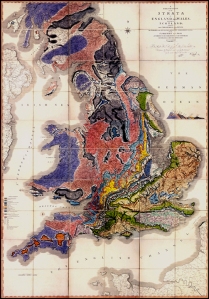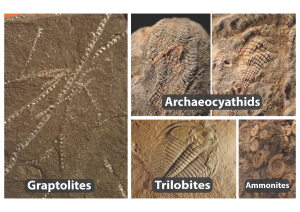Biostratigraphy is the branch of stratigraphy which focuses on correlating and assigning relative ages of rock strata by using the fossil assemblages contained within them. It relies on the study of in situ fossil distributions to allow recognition of stratigraphically restricted and geographically widespread taxa or populations, which enables subdivision and correlation of lithostratigraphical successions.
Although the concept is generally straightforward, in practice biostratigraphic studies tend to be complex. The complexities of biostratigraphy result from aspects of the biology of the organisms including their environmental range, their evolutionary rates, as well as their tendency for preservation and probability of observation by the biostratigrapher.
In 1796 William Smith, a British civil engineer, addressed this, adding the principle of Faunal  succession to those of Steno and Hutton. Essentially, Smith noted that:
succession to those of Steno and Hutton. Essentially, Smith noted that:
- Rock units were characterized by unique sets of fossil taxa;
- These sets of fossil taxa – faunas presumably represent the diversity of things living at the time the sediment was laid down;
- That the occurrance of many fossils was independent of the lithology of the rock.
In 1815, Smith published the first geologic map of England.
The concept of stage expresses a major subdivision of strata, each systematically following the other each bearing a unique assemblage of fossils called index fossils. Therefore, stages can be defined as a group of strata containing the same major fossil assemblages.
Index fossils
Index fossils are fossils used to define and identify geologic periods (or faunal stages). They work on the premise that, although different sediments may look different depending on the conditions under which they were laid down, they may include the remains of the same species of fossil.
Suitable fossil indices should be geographically widespread, common, stratigraphically restricted and morphologically distinct enough to enable unambiguous recognition.
Most long-established bizonations have relied on macrofossils, but drilling activities in both lakes and the sea, as well as in terrestrial settings, have led to the extensive use of microfossil groups. Principal microfossil groups studied extensively over the last 30 years include palynomorphs (spores, pollen, dinoflagellates), foraminifera (planktonic and benthic), nannoplankton, radiolaria, marine diatoms and ostracods. Ammonites, graptolites, archeocyathids, and trilobites are index fossils that are widely used in biostratigraphy.
Biostratigraphic units are divided into five principal kinds of biozones:
Range biozone
A range biozone is a body of rock representing the known stratigraphic and geographic range of occurrence of any selected element or elements in the rock record.
There are three types of range biozones:
– Taxon range biozone;
– Concurrent range biozone;
– Partial-range biozone.
A taxon-range biozone is a body of rock representing the known stratigraphic and geographic range of a chosen taxon.
A concurrent – range biozone is a body of rock including the concurrent, coincident, or overlapping part of the ranges of two specified taxa.
Partial range biozone is a body of rock located between the last appearance of a taxon and the first appearance of another taxon.
Range zones are especially useful in areas where the stratigraphical sequence is poorly understood, as they can be identified by the presence of the index taxon or taxa in isolated assemblages.
Interval biozone
An interval biozone is a body of rock between two specified biostratigraphic biohorizons (surfaces).
There are two types of interval biozones:
– The boundaries based on first appearance;
– The boundaries based on last appearance.
Where the full succession of strata in an area is better documented, however, greater biostratigraphical precision is normally possible using the interval zone. These are defined purely by their upper and lower boundaries, witch are placed in the stratigraphical sequence at defined levels called biohorizons, where there is a significant change in the fossil record , such as the lowest or highest occurrence of a taxon or taxa.
Lineage biozone
Based on a segment of phyletic lineage (chronospecies), the lineage biozone can be defined as a particular kind of range zone. A sequence of rages based on the successive evolutionary events of taxa on a lineage has a significance only in the succession of segments that defines it is recognizable on a large scale.
The lineage zone, which is sometimes called zone of consecutive existence, satisfies entirely the criterion of exclusion but not that of coexistence since, by definition, the recognized evolutionary stages do not overlap in time.
Assemblage biozone
An assemblage biozone is a body of rock characterized by a unique association of three or more taxa, the association of which distinguishes it in biostratigraphic character from adjacent strata.
An assemblage biozone may be based on a single taxonomic group, for example, trilobites, or on more that one group, such as acritarchs and chitinozoans.
Abundance (acme) biozone
An abundance biozone is a body of rock in which the abundance of a particular taxon or specified group of taxa is significantly greater than in adjacent parts of the section.
Abundance is a relative and subjective idea which implies great number, frequency and richness. The acme is the maximal increase in abundance of a taxon, independently of its stratigraphic distribution.
The boundaries of an interval of maximal abundance are not easily established and can be recognized only through a quantitative survey of the fossils assemblage.
Abundance zones may be of limited, local utility because abundances of taxa in the geologic record are largely controlled by paleoecology, taphonomy, and diagenesis.
Reasons for caution
Biostratigraphy opened the door to global correlation of strata, but is, nevertheless subject to biases and filters that make it most reliable on a local scale than a global one.
- There are no perfect index fossils.
- Even good ones are subject to some substrate/facies constraints.
- Many contain some biogeographic signal, such that local FADs(First Appearance Datum ) and LADs (Last Appearance Datum) may record immigration and extirpation. In effect, critters, as well as rock units, can be diachronous.
- The rock record is inconsistent. Thus:
- changes in depositional rate
- depositional hiatuses local facies changes impose their own non-biological signal.




